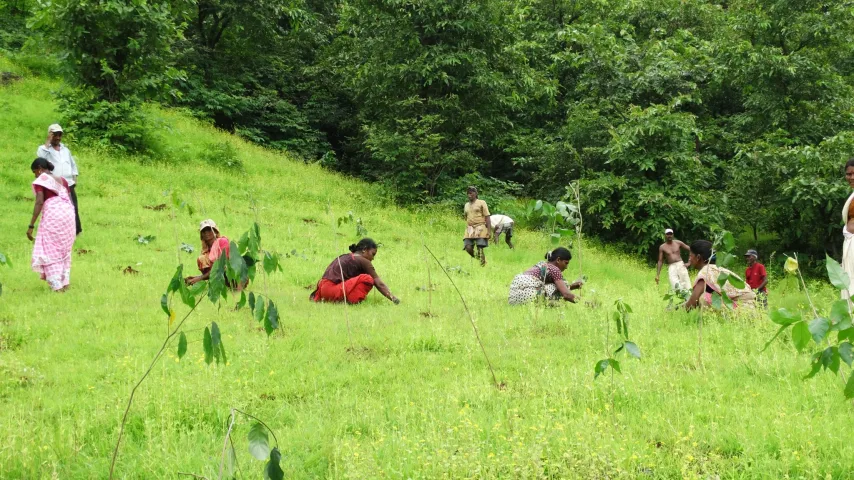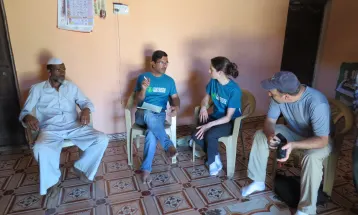India’s First Incentive-based Forest Restoration Program by Applied Environmental Research Foundation (AERF)

Hema Bhatt
Why restore nature? The rich tapestry of flora and fauna thriving in Maharashtra's Western Ghats, alongside the breathtaking mountain vistas is a stark reminder of the biodiversity loss caused by the degradation of ancient forests. Our journey began in 1996, amidst the northern reaches of the Western Ghats, as we embarked on our first ecological restoration project aimed at rejuvenating sacred groves in the Sangameshwar block of Ratnagiri district, Maharashtra. Sacred Groves are relic forest patches traditionally protected by communities in reverence of a deity. As a result, they are rich repositories of many plant and animal species of conservation significance. AERF has upheld the ecological restoration of 80 sacred groves so far and will continue to induce community action towards protection, restoration and management of these biodiversity havens in the Northern Western Ghats.That is what led the way till today. How does your project emphasize community-led initiatives? Our work at Applied Environmental Research Foundation on forest restoration is centered around sacred groves, which are primarily managed by communities and serve as vital areas for conserving high biodiversity. We prioritize understanding traditional conservation practices and communicating ecosystem threats to local communities. Community involvement is integral at every stage of our process. AERF operates in open-access forest landscapes where communities have owned and managed vast forest areas for centuries. In this region of the northern Western Ghats, AERF launched India’s first incentive-based forest restoration and conservation program in 2007 to halt deforestation and promote biodiversity conservation. Our first initiative, called Myforest uses the conservation agreement approach for securing long-term protection to degraded or healthy patches of biodiversity-rich forests in the northern Western Ghats - a global biodiversity hotspot. Since 2007, AERF has signed over 300 conservation agreements with local communities across 50 villages and brought 10,000 acres of forests on private land under long term conservation. AERF stands as the sole organization incentivizing forest protection and biodiversity conservation on private lands in India. We prioritize community participation and advocate for community-based restoration initiatives. Over the past three years, we have extended this approach to safeguarding mangroves on privately owned lands along the west coast of Maharashtra.

Elaborate on the economic viability of your work particularly in terms of having a positive impact on the local community. In 2014, AERF embarked on an experiment with an international certification program, FAIRWILD, aimed at establishing a market-based mechanism to generate sustainable income from standing forests in the Western Ghats. Through this initiative, we have successfully obtained FAIRWILD certification for about twenty old-growth forest fragments, resulting in economic returns for local communities through the sustainable collection and processing of certified materials. Recently, we replicated this approach to enhance the management of Community Forest Rights Resources (CFRR) in Chhattisgarh, bringing around 2800 hectares of CFRR under FAIRWILD certification. Given the nature of this model as a business venture, significant investment is required to scale up the conservation impact and fully harness the true economic potential of certified value chains. In addition, what distinguishes your project as truly exceptional, capable of inspiring a global audience? Local community involvement is paramount. We have been working in areas where no other conservation mechanisms exist. While treading this lesser-traveled path, we have identified core areas of work in order to achieve maximum impact and ensure that the forests and its people thrive through a symbiotic relationship. AERF has built a framework around them in order to engage in ‘participatory conservation’ or ‘community based conservation’. AERF has successfully convinced the global conservation community of the impact achievable through engaging local communities in the sustainable management and conservation of community forests over the long term. Our unique approach and the trust we have gained from local communities have enabled us to sustain the protection of old-growth forest patches restored in 1998 to the present day. We have established partnerships with renowned global conservation organizations such as Conservation International, The Nature Conservancy, Rainforest Trust, World Land Trust, and the British Ecological Society. Additionally, our team has garnered various awards in recognition of their contributions to biodiversity conservation, including the Whitley Associate Award, Conservation Leadership Award, IUCN Practitioner Fellowship, and National Geographic Explorer Grant, among others. More on Restor’s profile.